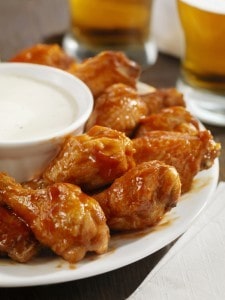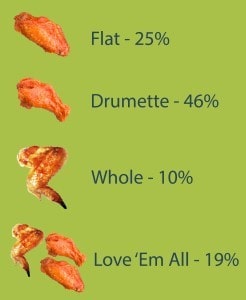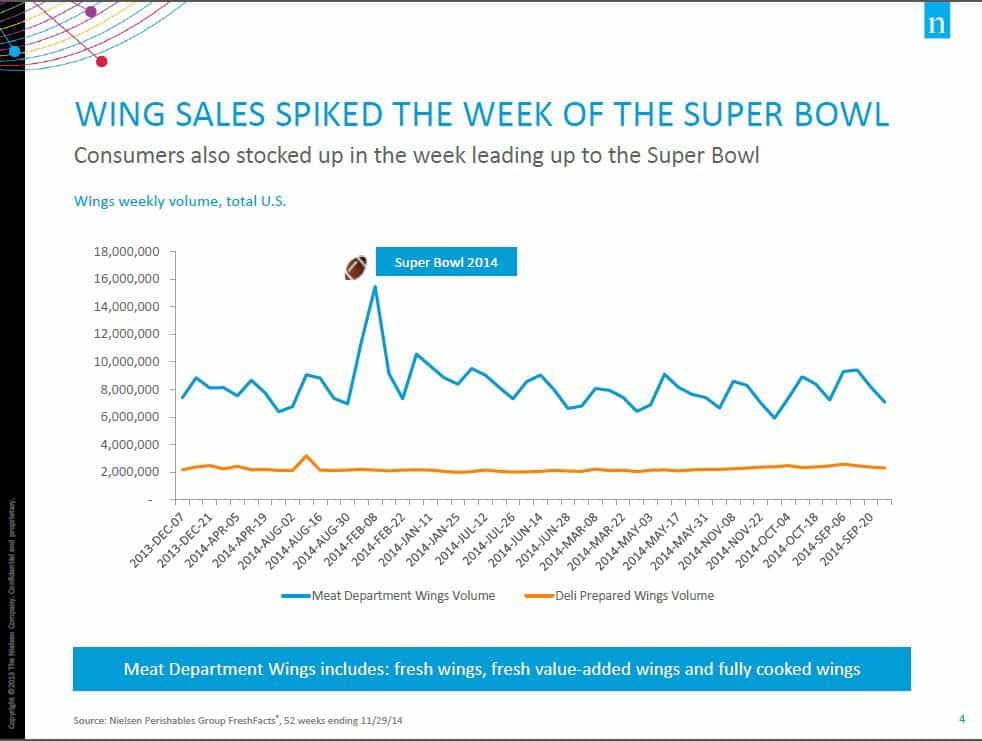High resolution photos of chicken wings are available to download here and here. Infographics of this data are available to download here and here.
Fans choose sides: Ranch hands Blue Cheese third consecutive defeat in poll
Washington, D.C. – With the second biggest eating day of the year after Thanksgiving upon us – Super Bowl Sunday – there’s no hotter time of year for chicken wings, which have become a staple food on Super Bowl menus.
According to the National Chicken Council’s 2015 Wing Report released today, 1.25 billion wings will be eaten during Super Bowl XLIX, as fans watch the Seattle Seahawks and New England Patriots battle for the Lombardi Trophy, matching the record tied last year when the Seahawks defeated the Denver Broncos.
 To put that into perspective, if 1.25 billion wing segments were laid end to end, they would stretch back and forth from CenturyLink Field in Seattle to Gillette Stadium in Foxborough, Massachusetts… almost 28 times. With the Super Bowl being played in Arizona, 1.25 billion wings would circle the Grand Canyon 120 times. That is enough wings to put 572 wings on every seat in all 32 NFL stadiums, according to the Council.
To put that into perspective, if 1.25 billion wing segments were laid end to end, they would stretch back and forth from CenturyLink Field in Seattle to Gillette Stadium in Foxborough, Massachusetts… almost 28 times. With the Super Bowl being played in Arizona, 1.25 billion wings would circle the Grand Canyon 120 times. That is enough wings to put 572 wings on every seat in all 32 NFL stadiums, according to the Council.
In terms of weight, 1.25 billion wings would weigh 5,955 times more than the weights of the Seahawks and Patriots entire 52-man rosters combined.
“Although the total amount of pounds of chicken produced last year rose by about 1.8 percent, the total number of chickens processed was virtually the same in 2014 as it was in 2013,” noted National Chicken Council Vice President of Communications Tom Super. “A chicken only has two wings; therefore, the supply of wings is limited by the total number of chickens produced.”
The average price (wholesale, not retail) of whole wings is currently $1.71/lb, up from $1.35/lb at the same time last year, according to the Daily Northeast Broiler/Fryer Report by the U.S. Department of Agriculture’s Agriculture Marketing Service. This is down significantly from when wing prices hit a record high of $2.11/lb in January, 2013.
Wing prices traditionally go up in the fourth quarter of the year as restaurants and supermarkets stock up for the Super Bowl, and prices usually peak in January during the run-up to the big game.
Wing Eating among NFC-AFC Championship Cities
While Seattle is known for many things, including its coffee, fish tossing and Fortune 500 companies, chicken wings aren’t one of them.

Residents of Seattle tend to punt on chicken wings, as they are 17 percent less likely to eat chicken wings in general than the average resident of the top 42 U.S. markets, according to The NPD Group’s Local Market CREST Restaurant database; two years ending September 2014. While faring a bit better, but still below average, Patriots fans in Boston are 8 percent less likely to consume wings from a restaurant than the average resident.
But the Seahawks-Patriots matchup was the best possible scenario out of the four remaining NFL playoff teams/cities for wing eating. Here’ a look at how the four stack up:
- Boston: 8 percent less likely to eat chicken wings in general than the average resident
- Seattle: 17 percent less likely to eat wings
- Indianapolis: 32 percent less likely to eat wings
- Green Bay: 39 percent less likely to eat wings
“The good news is, fans will try more wings if their team gets in the Super Bowl,” noted Harry Balzer, The NPD Group’s chief industry analyst and vice president. “We know wing consumption increases more than other foods during the Super Bowl. It did in Seattle last year after they won. While the citizens of Seattle still eat wings less often than the average eater, our research indicates that order incidence for wings rose considerably last year in that market.”
Added the Chicken Council’s Super, “With the Patriots in the game, we’re hopeful this trend will continue and we’ll see ‘inflated’ wing consumption this year in New England.”
Super Bowl Fans Choose Sides
The data shows that more than four in five U.S. adults (81 percent) eat chicken wings, holding steady from last year.
More than half (56 percent) of U.S. adults who eat chicken wings say they typically like to eat their wings with ranch dressing, according to a new National Chicken Council poll conducted online in January 2015 by Harris Poll*. Ranch is once again the #1 side or sauce typically eaten with wings, up from 51 percent last year but shy of the record of 57 percent two years ago. Only about one-third (36 percent) like to eat their wings with blue cheese dressing. This is up from 32 percent last year. Barbecue sauce even topped blue cheese, coming in at 42 percent.
The survey asked which dipping sauces or snacks chicken wing eaters typically like to eat with their wings. They could choose more than one option.
Northeastern wing eaters are significantly more likely to prefer blue cheese dressing (49 percent) than those in the Midwest (36 percent), South (30 percent) and West (30 percent), while those regions are more likely to prefer ranch dressing.
“I was shocked to see Blue Cheese go down by this margin, again,” noted Super. “Although, I’m from the Northeast – for me, putting Ranch on wings is like putting ketchup on a hot dog.”
After ranch dressing at the top: 42 percent of wing lovers choose barbecue sauce as a typical snack or dipping sauce; 36 percent said blue cheese; 36 percent hot sauce; 35 percent celery; and 20 percent choose carrots. Ten percent of wing lovers describe themselves as purists who eat nothing with their wings.
Bone-in or Boneless?
With the growing popularity of “boneless wings,” NCC asked wing eaters if they prefer to eat traditional, bone-in wings or boneless wings. According to the survey, 54 percent of wing eaters prefer traditional, bone-in wings while 46 percent chose their boneless cousin. Boneless wings are typically white, boneless chicken breasts cut into strips, breaded or floured and tossed with Buffalo sauce.
 The Drumette, Flat or Whole Wing?
The Drumette, Flat or Whole Wing?
The vast majority of wings, especially those destined for restaurants, are disjointed, with the third joint (the thin part known as the wing tip or flapper) being exported to Asian countries and the meatier first and second joints being sold domestically. The wing is usually split into two parts – or segments – known as the “drumette” and the “flat” and sold to restaurants or retail grocery outlets.
According the survey, of those who eat chicken wings, 46 percent prefer the drumette, 25 percent the flat and 10 percent prefer their wings whole. Nineteen percent say they don’t have a preference, they like them all.
Where do Americans Get their Wings?
The National Chicken Council estimates that of the wings eaten during the Super Bowl, 75 percent will come from food service outlets and 25 percent from retail grocery stores.
Although the vast majority of wings eaten during the Super Bowl are purchased from food service outlets, such as restaurants, bars and wing and pizza places, wing sales at grocery stores and supermarkets spike dramatically the week of the Super Bowl, and the data show that consumers also stock up the week before, too.
According to Nielsen Perishables Group FreshFacts® data, both fresh and prepared wings totaled $1.7 billion in sales at stores covered in their system for the 52 weeks ending November 29, 2014, an increase of 3.1 percent compared to a year earlier. Total pounds sold were up 3.9 percent to 543 million.
Consumers cooking their own wings at home can find traditional and unique chicken wing recipes on the National Chicken Council website at www.eatchicken.com
The Rest of the Year – 2015
Although America’s taste for chicken wings is no hotter than during Super Bowl weekend, the National Chicken Council estimates that overall in 2014 more than 14 billion chicken wings, more than 3.3 billion pounds, will be marketed as wings (as opposed to the wings on a whole or rotisserie chicken, for example). The actual number of wing portions sold is estimated to be 28 billion because, as noted above, the vast majority of wings are cut into two segments or portions.
Buffalo Chicken Wing History
Deep-fried chicken wings have long been a staple of Southern cooking. But the concept of cooking wings in peppery hot sauce was born in 1964 at the Anchor Bar in Buffalo, New York, when co-owner Teressa Bellissimo cooked leftover wings in hot sauce as a late-night snack for her son and his friends. The guys liked them so much that the Bellissimos put them on the menu the next day. Served with celery slices and bleu cheese sauce, “Buffalo Wings” were an instant hit.
 Dick Winger, who sold hot sauce to the bar, went on the road with Dominic Bellissimo, the owners’ son, to promote the item and sell hot sauce, and the item gradually caught on with restaurant operators around the country. The concept hit the big time in 1990, when McDonald’s began selling Mighty Wings at some of its restaurants. KFC rolled out Hot Wings a year later, and Domino’s Pizza introduced its own wings in 1994. They’ve remained hot ever since. McDonald’s was back in the wing business last year, and its Mighty Wings will be featured nationwide at most restaurants through the first quarter of 2014.
Dick Winger, who sold hot sauce to the bar, went on the road with Dominic Bellissimo, the owners’ son, to promote the item and sell hot sauce, and the item gradually caught on with restaurant operators around the country. The concept hit the big time in 1990, when McDonald’s began selling Mighty Wings at some of its restaurants. KFC rolled out Hot Wings a year later, and Domino’s Pizza introduced its own wings in 1994. They’ve remained hot ever since. McDonald’s was back in the wing business last year, and its Mighty Wings will be featured nationwide at most restaurants through the first quarter of 2014.
Chicken Wings and Football – A Love Story
The rise of the chicken wing and its correlation to American football all had to do with timing.
Cooking the whole bird was trendy in the sixties and seventies, but in the eighties U.S. consumers started preferring boneless-skinless breast meat, and wings became an inexpensive byproduct for chicken producers. Restaurants and bars realized they could charge low prices for the relatively inexpensive protein, and due to the spicy/salty nature of the sauce, they discovered that beer sales would go through the roof when customers ate wings.
At the same time, sports bars with multiple TVs and satellite dishes were becoming more and more common in America thanks to rapidly developing technology; and the most popular sporting event to watch with friends in bars is football. Wings were easily shareable and affordable, a great “group food” to eat with other people, and are the perfect pairing with a pitcher of beer. And so the pigskin-chicken wing bond was born.
###
*Survey Methodology
This survey was conducted online within the United States by Harris Poll on behalf of National Chicken Council from January 13-15, 2015 among 2,019 adults ages 18 and older (of whom 1,595 eat chicken wings). This online survey is not based on a probability sample and therefore no estimate of theoretical sampling error can be calculated. For complete survey methodology, including weighting variables, please contact Tom Super at [email protected]




